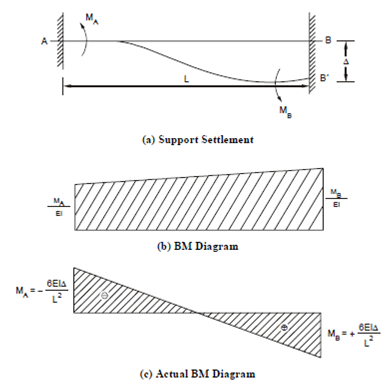As the change in slope from end B to A is θA, it is equal to the area of M/EI diagram between these points
i.e. θA = MA/EI .a/2 -MB/EI ((L-a)/2)
Also the intercept on the tangent at B made by the vertical through A is equal to the moment of M/EI diagram about A. Since the tangent at B passes by A, so this intercept is zero, hence,
(MA/EI.a/2)(a/3)-(MB/EI(L-a)/2)(a+2(L-a)/3))=0
Also we know from similar triangles that a/L-a = MA/MB
From Eq. (3.3),
MA. a2 = MB (L - a) [3a + a2 - 2 (L - a)]
Dividing by (L - a)2 we have
MA(a/L-a)2 =MB[3(a/L-a)+2]
On Substituting Eq. (3.4), we get
MA/MB (MA/MB)2 =3(MA/MB) +2
If MA/MB = r this gives r3 = 3r + 2 or r3 - 3r - 2 = 0
Giving (r + 1)2 (r - 2) = 0 hence r + 1 = 0 or r - 2 = 0
As the ratio r = MA/MB = - 1 is not acceptable since MA = - MB gives the case of a uniform sagging moment all over the beam, thus,
∴ MA/MB =2 or MA =2MB
Also a/L-a =MA/MB =2 or a 2L/3
Substituting Eqs. (3.5) and (3.6) in Eq. (3.2), we get
MA = 4EI θA /L
and ∴ MB= MA/2 =2EI θA /L
Thus, a rotation of θA at hinged end A is produced by a moment 4EI θA /L at the end A, while at the fixed end B the moment induced is half of this, i.e. 2 EI θA/L and both are clockwise if θA is clockwise.
Next, let us compute the fixed end moments due to a support settlement or end deflection as shown in Figure 6(a).

Figure